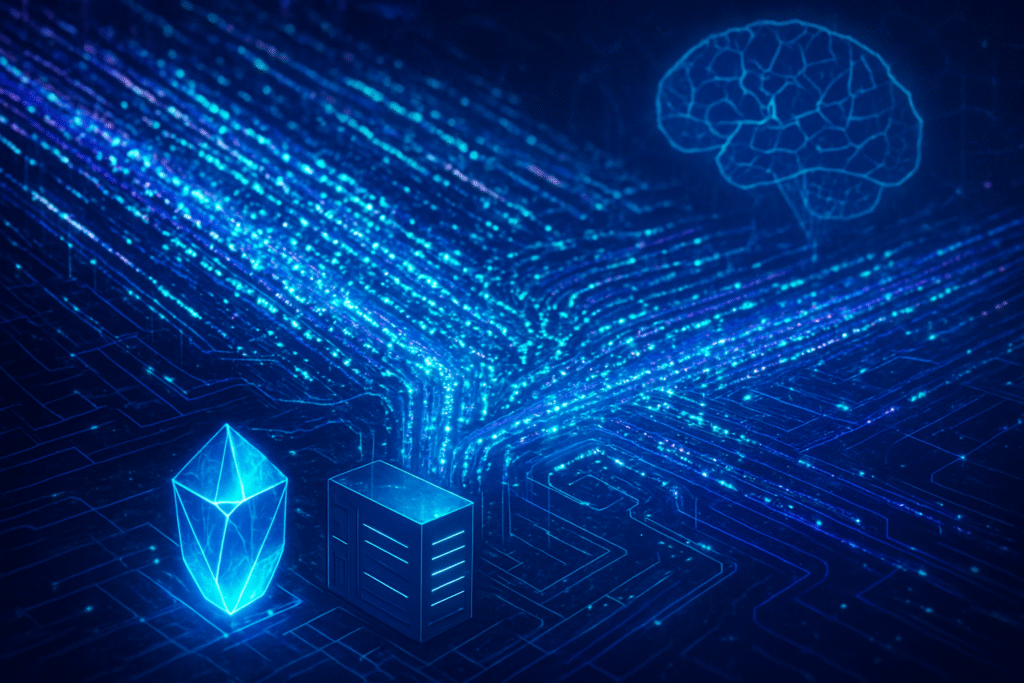
The relentless march of Artificial Intelligence is poised to unleash a data deluge of unprecedented proportions, with some experts predicting AI will generate data at rates potentially 1,000 times greater than human output. This exponential surge, driven largely by the advent of generative AI, presents both a transformative opportunity for technological advancement and an existential challenge for global data storage infrastructure. The implications are immediate and far-reaching, demanding innovative solutions and a fundamental re-evaluation of how digital information is managed and preserved.
This data explosion is not merely a forecast but an ongoing reality, deeply rooted in the current exponential growth of data attributed to AI systems. While a precise, universally attributed prediction of "AI will generate 1,000 times more data than humans" for a specific timeframe is less common, the overarching consensus among experts is the staggering acceleration of AI-driven data. With the global datasphere projected to reach 170 zettabytes by 2025, AI is unequivocally identified as a primary catalyst, creating a self-reinforcing feedback loop where more data fuels better AI, which in turn generates even more data at an astonishing pace.
The Technical Engine of Data Generation: Generative AI at the Forefront
The exponential growth in AI data generation is fueled by a confluence of factors: continuous advancements in computational power, sophisticated algorithmic breakthroughs, and the sheer scale of modern AI systems. Hardware accelerators like GPUs and TPUs, consuming significantly more power than traditional CPUs, enable complex deep learning models to process vast amounts of data at unprecedented speeds. These models operate on a continuous cycle of learning and refinement, where every interaction is logged, contributing to ever-expanding datasets. For instance, the compute used to train Minerva, an AI solving complex math problems, was nearly 6 million times that used for AlexNet a decade prior, illustrating the massive scale of data generated during training and inference.
Generative AI (GenAI) stands as a major catalyst in this data explosion due to its inherent ability to create new, original content. Unlike traditional AI that primarily analyzes existing data, GenAI proactively produces new data in various forms—text, images, videos, audio, and even software code. Platforms like ChatGPT, Gemini, DALL-E, and Stable Diffusion exemplify this by generating human-like conversations or images from text prompts. A significant contribution is the creation of synthetic data, artificially generated information that replicates statistical patterns of real data without containing personally identifiable information. This synthetic data is crucial for overcoming data scarcity, enhancing privacy, and training AI models, often outperforming real data alone in certain scenarios, such as simulating millions of accident scenarios for autonomous vehicles.
The types of data generated are diverse, but GenAI primarily excels with unstructured data—text, images, audio, and video—which constitutes approximately 80% of global data. While structured and numeric data are still vital for AI applications, the proactive creation of unstructured and synthetic data marks a significant departure from previous data generation patterns. This differs fundamentally from earlier data growth, which was largely reactive, analyzing existing information. The current AI-driven data generation is proactive, leading to a much faster and more expansive creation of novel information. This unprecedented scale and velocity of data generation are placing immense strain on data centers, which now require 3x more power per square foot than traditional facilities, demanding advanced cooling systems, high-speed networking, and scalable, high-performance storage like NVMe SSDs.
Initial reactions from the AI research community and industry experts are a mix of excitement and profound concern. Experts are bracing for an unprecedented surge in demand for data storage and processing infrastructure, with electricity demands of data centers potentially doubling worldwide by 2030, consuming more energy than entire countries. This has raised significant environmental concerns, prompting researchers to seek solutions for mitigating increased greenhouse gas emissions and water consumption. The community also acknowledges critical challenges around data quality, scarcity, bias, and privacy. There are concerns about "model collapse" where AI models trained on AI-generated text can produce increasingly nonsensical outputs, questioning the long-term viability of solely relying on synthetic data. Despite these challenges, there's a clear trend towards increased AI investment and a recognition that modernizing data storage infrastructure is paramount for capitalizing on machine learning opportunities, with security and storage being highlighted as the most important components for AI infrastructure.
Corporate Battlegrounds: Beneficiaries and Disruptors in the Data Era
The explosion of AI-generated data is creating a lucrative, yet fiercely competitive, environment for AI companies, tech giants, and startups. Companies providing the foundational infrastructure are clear beneficiaries. Data center and infrastructure providers, including real estate investment trusts (REITs) like Digital Realty Trust (NYSE: DLR) and equipment suppliers like Super Micro Computer (NASDAQ: SMCI) and Vertiv (NYSE: VRT), are experiencing unprecedented demand. Utility companies such as Entergy Corp. (NYSE: ETR) and Southern Co. (NYSE: SO) also stand to benefit from the soaring energy consumption of AI data centers.
Chipmakers and hardware innovators are at the heart of this boom. Nvidia (NASDAQ: NVDA) and Advanced Micro Devices (AMD: NASDAQ) are current leaders in AI Graphics Processing Units (GPUs), but major cloud providers like Alphabet (NASDAQ: GOOGL) (Google), Amazon (NASDAQ: AMZN) (AWS), and Microsoft (NASDAQ: MSFT) (Azure) are heavily investing in developing their own in-house AI accelerators (e.g., Google's TPUs, Amazon's Inferentia and Trainium chips). This in-house development intensifies competition with established chipmakers and aims to optimize performance and reduce reliance on third-party suppliers. Cloud Service Providers (CSPs) themselves are critical, competing aggressively to attract AI developers by offering access to their robust infrastructure. Furthermore, companies specializing in AI-powered storage solutions, such as Hitachi Vantara (TYO: 6501), NetApp (NASDAQ: NTAP), Nutanix (NASDAQ: NTNX), and Hewlett Packard Enterprise (NYSE: HPE), are gaining traction by providing scalable, high-performance storage tailored for AI workloads.
The competitive landscape is marked by intensified rivalry across the entire AI stack, from hardware to algorithms and applications. The high costs of training AI models create significant barriers to entry for many startups, often forcing them into "co-opetition" with tech giants for access to computing infrastructure. A looming "data scarcity crisis" is also a major concern, as publicly available datasets could be exhausted between 2026 and 2032. This means unique, proprietary data will become an increasingly valuable competitive asset, potentially leading to higher costs for AI tools and favoring companies that can secure exclusive data partnerships or innovate with smaller, more efficient models.
AI's exponential data generation is set to disrupt a wide array of existing products and services. Industries reliant on knowledge work, such as banking, pharmaceuticals, and education, will experience significant automation. Customer service, marketing, and sales are being revolutionized by AI-powered personalization and automation. Generative AI is expected to transform the overwhelming majority of the software market, accelerating vendor switching and prompting a reimagining of current software categories. Strategically, companies are investing in robust data infrastructure, leveraging proprietary data as a competitive moat, forming strategic partnerships (e.g., Nvidia's investment in cloud providers like CoreWeave), and prioritizing cost optimization, efficiency, and ethical AI practices. Specialization in vertical AI solutions also offers startups a path to success.
A New Era: Wider Significance and the AI Landscape
The exponential generation of data is not just a technical challenge; it's a defining characteristic of the current technological era, profoundly impacting the broader AI landscape, society, and the environment. This growth is a fundamental pillar supporting the rapid advancement of AI, fueled by increasing computational power, vast datasets, and continuous algorithmic breakthroughs. The rise of generative AI, with its ability to create new content, represents a significant leap from earlier AI forms, accelerating innovation across industries and pushing the boundaries of what AI can achieve.
The future of AI data storage is evolving towards more intelligent, adaptive, and predictive solutions, with AI itself being integrated into storage technologies to optimize tasks like data tiering and migration. This includes the development of high-density flash storage and the extensive use of object storage for massive, unstructured datasets. This shift is crucial as AI moves through its conceptual generations, with the current era heavily reliant on massive and diverse datasets for sophisticated systems. Experts predict AI will add trillions to the global economy by 2030 and has the potential to automate a substantial portion of current work activities.
However, the societal and environmental impacts are considerable. Environmentally, the energy consumption of data centers, the backbone of AI operations, is skyrocketing, projected to consume nearly 50% of global data center electricity in 2024. This translates to increased carbon emissions and vast water usage for cooling. While AI offers promising solutions for climate change (e.g., optimizing renewable energy), its own footprint is a growing concern. Societally, AI promises economic transformation and improvements in quality of life (e.g., healthcare, education), but also raises concerns about job displacement, widening inequality, and profound ethical quandaries regarding privacy, data protection, and transparency.
The efficacy and ethical soundness of AI systems are inextricably linked to data quality and bias. The sheer volume and complexity of AI data make maintaining high quality difficult, leading to flawed AI outputs or "hallucinations." Training data often reflects societal biases, which AI systems can amplify, leading to discriminatory practices. The "black box" nature of complex AI models also challenges transparency and accountability, hindering the identification and rectification of biases. Furthermore, massive datasets introduce security and privacy risks. This current phase of AI, characterized by generative capabilities and exponential compute growth (doubling every 3.4 months since 2012), marks a distinct shift from previous AI milestones, where the primary bottleneck has moved from algorithmic innovation to the effective harnessing of vast amounts of domain-specific, high-quality data.
The Horizon: Future Developments and Storage Solutions
In the near term (next 1-3 years), the data explosion will continue unabated, with data growth projected to reach 180 zettabytes by 2025. Cloud storage and hybrid solutions will remain central, with significant growth in spending on Solid State Drives (SSDs) using NVMe technology, which are becoming the preferred storage media for AI data lakes. The market for AI-powered storage is rapidly expanding, projected to reach $66.5 billion by 2028, as AI is increasingly integrated into storage solutions to optimize data management.
Longer term (3-10+ years), the vision includes AI-optimized storage architectures, quantum storage, and hyper-automation. DNA-based storage is being explored as a high-density, long-term archiving solution. Innovations beyond traditional NAND flash, such as High Bandwidth Flash (HBF) and Storage-Class Memory (SCM) like Resistive RAM (RRAM) and Phase-Change Memory (PCM), are being developed to reduce AI inference latency and increase data throughput with significantly lower power consumption. Future storage architectures will evolve towards data-centric composable systems, allowing data to be placed directly into memory or flash, bypassing CPU bottlenecks. The shift towards edge AI and ambient intelligence will also drive demand for intelligent, low-latency storage solutions closer to data sources, with experts predicting 70% of AI inference workloads will eventually be processed at the edge. Sustainability will become a critical design priority, focusing on energy efficiency in storage solutions and data centers.
Potential applications on the horizon are vast, ranging from advanced generative AI and LLMs, real-time analytics for fraud detection and personalized experiences, autonomous systems (self-driving cars, robotics), and scientific research (genomics, climate modeling). Retrieval-Augmented Generation (RAG) architectures in LLMs will require highly efficient, low-latency storage for accessing external knowledge bases during inference. AI and ML will also enhance cybersecurity by identifying and mitigating threats.
However, significant challenges remain for data storage. The sheer volume, velocity, and variety of AI data overwhelm traditional storage, leading to performance bottlenecks, especially with unstructured data. Cost and sustainability are major concerns, with current cloud solutions incurring high charges and AI data centers demanding skyrocketing energy. NAND flash technology, while vital, faces its own challenges: physical limitations as layers stack (now exceeding 230 layers), performance versus endurance trade-offs, and latency issues compared to DRAM. Experts predict a potential decade-long shortage in NAND flash, driven by surging AI demand and manufacturers prioritizing more profitable segments like HBM, making NAND flash a "new scarce resource."
Experts predict a transformative period in data storage. Organizations will focus on data quality over sheer volume. Storage architectures will become more distributed, developer-controlled, and automated. AI-powered storage solutions will become standard, optimizing data placement and retrieval. Density and efficiency improvements in hard drives (e.g., Seagate's (NASDAQ: STX) HAMR drives) and SSDs (up to 250TB for 15-watt drives) are expected. Advanced memory technologies like RRAM and PCM will be crucial for overcoming the "memory wall" bottleneck. The memory and storage industry will shift towards system collaboration and compute-storage convergence, with security and governance as paramount priorities. Data centers will need to evolve with new cooling solutions and energy-efficient designs to address the enormous energy requirements of AI.
Comprehensive Wrap-up: Navigating the Data-Driven Future
The exponential generation of data by AI is arguably the most significant development in the current chapter of AI history. It underscores a fundamental shift where data is not merely a byproduct but the lifeblood sustaining and propelling AI's evolution. Without robust, scalable, and intelligent data storage and management, the potential of advanced AI models remains largely untapped. The challenges are immense: petabytes of diverse data, stringent performance requirements, escalating costs, and mounting environmental concerns. Yet, these challenges are simultaneously driving unprecedented innovation, with AI itself emerging as a critical tool for optimizing storage systems.
The long-term impact will be a fundamentally reshaped technological landscape. Environmentally, the energy and water demands of AI data centers necessitate a global pivot towards sustainable infrastructure and energy-efficient algorithms. Economically, the soaring demand for AI-specific hardware, including advanced memory and storage, will continue to drive price increases and resource scarcity, creating both bottlenecks and lucrative opportunities for manufacturers. Societally, while AI promises transformative benefits across industries, it also presents profound ethical dilemmas, job displacement risks, and the potential for amplifying biases, demanding proactive governance and transparent practices.
In the coming weeks and months, the tech world will be closely watching several key indicators. Expect continued price surges for NAND flash products, with contract prices projected to rise by 5-10% in Q4 2025 and extending into 2026, driven by AI's insatiable demand. By 2026, AI applications are expected to consume one in five NAND bits, highlighting its critical role. The focus will intensify on Quad-Level Cell (QLC) NAND for its cost benefits in high-density storage and a rapid increase in demand for enterprise SSDs to address server market recovery and persistent HDD shortages. Persistent supply chain constraints for both DRAM and NAND will likely extend well into 2026 due to long lead times for new fabrication capacity. Crucially, look for continued advancements in AI-optimized storage solutions, including Software-Defined Storage (SDS), object storage tailored for AI workloads, NVMe/NVMe-oF, and computational storage, all designed to support the distinct requirements of AI training, inference, and the rapidly developing "agentic AI." Finally, innovations aimed at reducing the environmental footprint of AI data centers will be paramount.
This content is intended for informational purposes only and represents analysis of current AI developments.
TokenRing AI delivers enterprise-grade solutions for multi-agent AI workflow orchestration, AI-powered development tools, and seamless remote collaboration platforms.
For more information, visit https://www.tokenring.ai/





